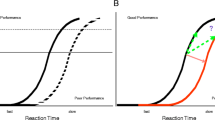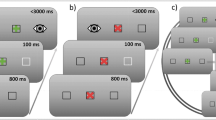Abstract
A preceding antisaccade increases the latency of the saccade in the next trial. Whether this inter-trial effect is generated by the preparation or the execution of the antisaccade is not certain. Our goal was to examine the inter-trial effects from trials on which subjects prepared an antisaccade but did not make one. We tested 15 subjects on blocks of randomly ordered prosaccades and antisaccades. An instructional cue at fixation indicated whether a prosaccade or antisaccade was required, with the target appearing 2 s later. On 20 % of antisaccade trials, the target did not appear (prepared-only antisaccade trials). We analyzed the latencies of all correct prosaccades or antisaccades preceded by correctly executed trials. The latencies of prosaccade trials were 15 ms shorter if they were preceded by prosaccades than if the prior trial was an antisaccade. Prosaccades preceded by trials on which antisaccades were cued but not executed also showed prolonged latencies that were equivalent to those preceded by executed antisaccades. We conclude that the inter-trial effects from a prior antisaccade are generated by its preparation rather than its execution. This may reflect persistence of pre-target preparatory activity from the prior trial to affect that of the next trial in structures like the superior colliculus and frontal eye field.


Similar content being viewed by others
References
Abegg M, Rodriguez AR, Lee H, Barton JJ (2010) ‘Alternate-goal bias’ in antisaccades and the influence of expectation. Exp Brain Res 203:553–562
Baguley T (2012) Calculating and graphing within-subject confidence intervals for ANOVA. Behav Res Methods 44:158–175
Barton J, Greenzang C, Hefter R, Edelman J, Manoach D (2006a) Switching, plasticity, and prediction in a saccadic task-switch paradigm. Exp Brain Res 168:76–87
Barton J, Raoof M, Jameel O, Manoach D (2006b) Task-switching with antisaccades versus no-go trials: a comparison of inter-trial effects. Exp Brain Res 172:114–119
Brown MR, Vilis T, Everling S (2007) Frontoparietal activation with preparation for antisaccades. J Neurophysiol 98:1751–1762
Chan JL, DeSouza JF (2013) The effects of attentional load on saccadic task switching. Exp Brain Res 227:301–309
Cherkasova M, Manoach D, Intriligator J, Barton J (2002) Antisaccades and task-shifting: interactions in controlled processing. Exp Brain Res 144:528–537
Connolly J, Goodale M, Menon R, Munoz D (2002) Human fMRI evidence for the neural correlates of preparatory set. Nat Neurosci 5:1345–1352
Desimone JC, Weiler J, Aber GS, Heath M (2014) The unidirectional prosaccade switch-cost: correct and error antisaccades differentially influence the planning times for subsequent prosaccades. Vis Res 96:17–24
Dorris M, Paré M, Munoz D (2000) Immediate neural plasticity shapes motor performance. J Neurosci 20:52
Everling S, Fischer B (1998) The antisaccade: a review of basic research and clinical studies. Neuropsychologia 36:885–899
Everling S, Munoz DP (2000) Neuronal correlates for preparatory set associated with pro-saccades and anti-saccades in the primate frontal eye field. J Neuriosci 20:387–400
Everling S, Dorris MC, Klein RM, Munoz DP (1999) Role of primate superior colliculus in preparation and execution of anti-saccades and pro-saccades. J Neurosci 19:2740–2754
Fecteau J, Munoz D (2003) Exploring the consequences of the previous trial. Nat Rev Neurosci 4:435–443
Fecteau J, Au C, Armstrong I, Munoz D (2004) Sensory biases produce alternation advantage found in sequential saccadic eye movement tasks. Exp Brain Res 159:84–91
Ford KA, Goltz HC, Brown MR, Everling S (2005) Neural processes associated with antisaccade task performance investigated with event-related FMRI. J Neurophysiol 94:429–440
Franke C, Reuter B, Breddin A, Kathmann N (2009) Response switching in schizophrenia patients and healthy subjects: effects of the inter-response interval. Exp Brain Res 196:429–438
Hallett PE (1978) Primary and secondary saccades to goals defined by instructions. Vis Res 18:1279–1296
Hallett P, Adams B (1980) The predictability of saccadic latency in a novel voluntary oculomotor task. Vis Res 20:329–339
Manoach DS, Thakkar KN, Cain MS, Polli FE, Edelman JA, Fischl B, Barton JJ (2007) Neural activity is modulated by trial history: a functional magnetic resonance imaging study of the effects of a previous antisaccade. J Neurosci 27:1791–1798
Manoach DS, Lee AK, Hamalainen MS, Dyckman KA, Friedman JS, Vangel M, Goff DC, Barton JJ (2013) Anomalous use of context during task preparation in schizophrenia: a magnetoencephalography study. Biol Psychiatry 73:967–975
Meiran N (2000) Modeling cognitive control in task switching. Psychol Res 63:234–249
Munoz D, Everling S (2004) Look away: the anti-saccade task and the voluntary control of eye movement. Nat Rev Neurosci 5:218–228
Polli FE, Barton JJ, Vangel M, Goff DC, Iguchi L, Manoach DS (2006) Schizophrenia patients show intact immediate error-related performance adjustments on an antisaccade task. Schizophr Res 82:191–201
Rabbitt PM (1966) Errors and error correction in choice-response tasks. J Exp Psychol 71:264–272
Rastgardani T, Lau V, Barton JJ, Abegg M (2012) Trial history biases the spatial programming of antisaccades. Exp Brain Res 222:175–183
Reuter B, Philipp A, Koch I, Kathmann N (2006) Effects of switching between leftward and rightward pro- and antisaccades. Biol Psychol 72:88–95
Rogers RD, Monsell S (1995) Costs of a predictable switch between simple cognitive tasks. J Exp Psychol Gen 124:207–231
Weiler J, Heath M (2012) Task-switching in oculomotor control: unidirectional switch-cost when alternating between pro- and antisaccades. Neurosci Lett 530:150–154
Weiler J, Mitchell T, Heath M (2014) Response suppression delays the planning of subsequent stimulus-driven saccades. PLoS ONE 9:e86408
Wolfinger R, Tobias R, Sall J (1994) Computing Gaussian likelihoods and their derivatives for general linear mixed models. SIAM J Sci Comput 15:1294–1310
Acknowledgments
JB was supported by a Canada Research Chair and the Marianne Koerner Chair in Brain Diseases. This work was supported by CIHR Grant MOP-81270.
Author information
Authors and Affiliations
Corresponding author
Rights and permissions
About this article
Cite this article
Yeung, S., Rubino, C., Viswanathan, J. et al. The inter-trial effect of prepared but not executed antisaccades. Exp Brain Res 232, 3699–3705 (2014). https://doi.org/10.1007/s00221-014-4057-z
Received:
Accepted:
Published:
Issue Date:
DOI: https://doi.org/10.1007/s00221-014-4057-z




